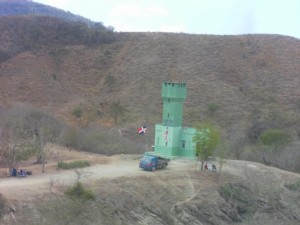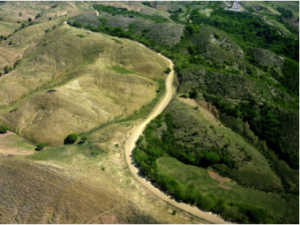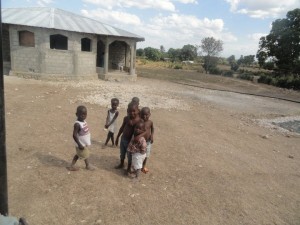A faded castle amidst a dry and desolate landscape: my last image of Haiti still sears like a hot burn in my mind.
Traveling over roads that were nothing more than rutted ditches and dried creek beds, we were heading for the Haitian border. Our plans to fly out of Port-au-Prince that morning had been derailed by news that Aristide, Haiti’s former ruler, had decided to return from exile. Hoping to avoid election turmoil and possible violence in the Haitian capital, we decided to attempt a dusty, daring escape out through the Dominican Republic (DR) instead.
I had witnessed desperation in Haiti: arid soils, food scarcity, disease, malnutrition, and polluted drinking water. However, driving into the forested mountains of the DR, I finally realized what Haiti had truly lost. It had lost its green: the green of life, the green that meant water and food and hope.
In the late 1600s, France took over the western part of the island of Hispaniola from Spain, dividing the island into what is now Haiti and the DR.1 Like a science experiment gone wrong, the border now demarks not only linguistic differences, but also an entirely different quality of life. In 1960, both countries experienced essentially the same rainfall patterns and enjoyed the same geography, availability of natural resources, and land productivity.2 The countries had nearly the same per capita real GDP.2 However, by 2005, the Dominican Republic’s per capita real GDP had increased threefold, while Haiti’s had plummeted.2 Now, the average person in the DR can expect to live a full ten years longer than their neighbor in Haiti.3,4 The percentage of the population below the minimum level of dietary energy consumption is 44.5% in Haiti, compared to 15.4% in the DR.3,4 The probability of dying under the age of 5 per 1,000 births in Haiti in 76, while in DR, the number is less than half of that.3,4 The DR has become a magnet for tourism, while Haiti has become a social, political, and economic tragedy. What happened?
In 1950, forest clearing for plantations and wood exports in Haiti had largely ended, but wood harvesting for charcoal continued.5 A mere thirty years later, forest cover had diminished from 25% of the total land area to a meager 10%. It decreased again to 4% of the land by 1994.5
Across the border, the Dominican Republic initially suffered from deforestation as well. Tree cover plummeted from 75% of the land in 1922 to 12% by the 1980s.5 However, massive reforestation programs and a conscious shift to alternative energy sources (besides charcoal) allowed the trees to rebound. The nation established thirteen national parks and restricted access to important forest reserves.6 Today, forest covers 28% of the country.5
So what was the connection between the dying children I held in my arms in Hinche, Haiti, and dusty landscape that they lived in? What was the relationship between the tropical forest and the avocados in the fruit markets of the DR? Why would I leave one country in tears, and the other with memories of bachata music and Corona beer? The answer is simple: trees bring life.
Forests prevent soil erosion. Sturdy trunks slow winds. Roots hold the soil in place and improve soil permeability. They allow water to percolate into underground aquifers, decreasing surface water runoff. Leaves lessen the impact of heavy rains and reduce flooding. Dead trees, leaves, and bark add organic matter to the topsoil, completing nutrient cycles and replenishing the land. Forests act as natural buffers as well, slowing floodwaters and shielding the coast from hurricane surges. In 2004, Hurricane Jeanne killed more than 3,000 people in Haiti, while the DR lost nineteen.5 While other factors undoubtedly contributed to these numbers, the ability of forested coasts and watershed areas to mitigate hurricane damage is undeniable.
The UN estimates that “50% of the (Haitian) topsoil has been washed away into the ocean” and that damaged lands have become “irreclaimable for farming purposes”.5 Although nearly 60 percent of the Haitian people work in the agricultural sector, the country still must import nearly half of its food. Even so, nearly 30% of Haitian children endure chronic malnutrition.7
While Haiti has also suffered from serious political strife since 1960, environmental degradation remains one of its greatest challenges. We cannot continue to view environmental policies as counter to economic growth and human happiness, but as necessary to achieve them. Climate change and an ever-increasing population mean that decisions have to be made now. And the time to think sustainably has come.






This is such a interesting perspective on how environmental impact can have economic and social impacts. I would not have made this connection in simply thinking about Haiti’s strife. What type of plan would you suggest to remedy Haiti’s situation?
You made a really interesting connection here – one that had not previously been brought to my attention. How interesting that the environmental degradation of a land could correlate so directly with it’s health, welfare and wealth.
I agree, that I think that there are extenuating circumstances that have lead to the current strife in Haiti. That being said, it will be interesting to see how the country will change environmentally in the coming years. I think that perhaps the country would be a good model for the introduction of nonnative species that take well to arid regions. Although this will not bring agriculture possibilities back to Haiti initially, perhaps it can at least increase the health of the land and bring back some form of ecotourism.
I know that the Dominican Republic relies on eco-tourism for a significant portion of income. This could be a more feasible direction for Haiti to strive towards as opposed to agricultural output, because it will prioritize the health of the land.
It really is incredible the difference between the two countries sharing the same relatively small island. Unfortunately, I imagine things only getting worse for Haiti as climate change continues to worsen. I think this is a great example of why developing nations need to be provided motivation and assistance to develop in a sustainable manner.
As we saw in the DR, it may sacrifice income in the short term, but has many long term benefits.
This is such a great case study. You make a great comparison between the DR and Haiti. This really makes me think about the true harm of anthropocentric thinking. When we only think about human needs, we ironically decrease the quality of human life. Though as you mention, political strife also caused many of the problems in Haiti, but the environment still serves as the root of all of these issues. When people are not fed, the country cannot simply operate. Ghettos form, revolts evolve, and children die. It’s a terrible situation that Haiti’s in, however do you think that Haiti could ever rebound back to the forestation levels of the DR? Perhaps only then will Haiti be able to rebuild itself.
Your post truly sheds light on the importance of healthy ecosystems- especially your juxtaposition of the conditions in Haiti and the DR. I appreciated your connection between environmental degradation and the how that causes degradation of an economy. By exploiting forests for economic gain, Haiti exposed its citizens to poorer health situations and natural disasters related to human induced climate change. I know that you were not in Haiti for a long period of time but did you witness any efforts to address deforestation? Were there signs of international aid that promoted reforestation like the programs available to the DR?
-Julie Rohde
This is a fascinating piece and offers a fresh perspective on the divergence of human welfare on the two sides of Hispaniola. The aerial shot of (what I assume is) the Haitian/Dominican border is particularly well-placed. I’ve seen similar photos that contrast economic conditions across borders (see, e.g., the first chapter of Acemoglu and Robinson’s “Why Nations Fail”), but never something so environmentally dramatic. That said, while I agree with your hypothesis that environmental degradation is *a* factor in the countries’ economic divergence (and is a fascinating case study regardless), I think it is inappropriate to suggest that it is a primary factor. The root cause in this case seems clearly to be institutional or cultural. As you mention, the two countries are for practical purposes geographically identical: they are located on the same island, are subject to the same weather patterns, and have similar natural endowments. The cultural hypothesis can also probably be rejected on analogous grounds. But the European division of the island is an exogenous event that seems to have had causal impact on the institutional evolutions of each country. If anything, your argument suggests that political institutions, broadly conceived, are at fault for the countries’ economic divergence. Environmental degradation is then a symptom of “bad policy” or “bad institutions,” though I don’t dispute your claim that it independently affects human welfare. But, from a policy perspective, attention should be directed toward correcting the root problem, which in this case is an institutional failure.